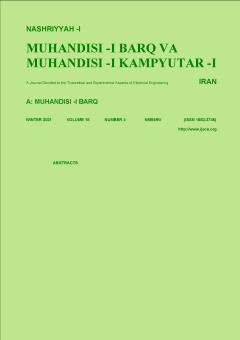Hybrid Beamforming in MIMO Systems via Matrix Decomposition
Subject Areas : electrical and computer engineering
1 - دانشگاه اصفهان
2 -
3 -
Keywords: MIMO systemsRF chainhybrid beamforming,
Abstract :
MIMO systems, and particularly massive MIMO systems, achieve high spectral efficiency by using a large number of antennas. An important issue in these systems is beamforming. In fully digital baseband beamforming, an RF chain is required for each antenna, which leads to high cost and power consumption. In analog beamforming, only one RF chain is used and beamforming is performed by using phase shifters. This method does not provide optimal spectral efficiency and thus, analog-digital hybrid methods for beamforming are considered. In this paper, a hybrid beamforming method is proposed in which the required number of RF chains is much less than fully digital method. The precoder and receiver filter are designed by maximizing the spectral efficiency. To this end, the optimal beamforming matrix (which contains the right singular vectors of the channel matrix) is approximated by the product of two analog and digital beamforming matrices. This approximation is improved by an iterative method. The criterion for the proximity of the two matrices is considered to be the Frobenius norm of their differences. In the receiver, the design of the hybrid beamforming is performed in a similar way, using the mean squares error criterion. Also, to improve the method, a gradient-based algorithm is proposed to further reduce the error. The simulation results show the performance superiority of the proposed method over similar methods as well as its less complexity.
[1] A. Goldsmith, Wireless Communications, Cambridge University Press, 2005.
[2] L. Lu, et al., "An overview of massive MIMO: benefits and challenges," IEEE J. of Selected Topics in Signal Processing, vol. 8, no. 5, pp. 742-758, Oct. 2014.
[3] B. D. Van Veen and K. M. Buckley, "Beamforming: a versatile approach to spatial filtering," IEEE Assp Magazine, vol. 5, no. 2, pp. 4-24, Apr. 1988.
[4] W. Ni, X. Dong, and W. S. Lu, "Near-optimal hybrid processing for massive MIMO systems via matrix decomposition," IEEE Trans. on Signal Processing, vol. 65, no. 15, pp. 3922-3933, 1 Aug. 2017.
[5] F. Sohrabi and W. Yu, "Hybrid beamforming with finite-resolution phase shifters for large-scale MIMO systems," in Proc. IEEE 16th In. Workshop on Signal Processing Advances in Wireless Communications, SPAWC’15, pp. 136-140, Stockholm, Sweden, 28 June-1 Jul. 2015.
[6] O. El Ayach, S. Rajagopal, S. Abu-Surra, Z. Pi, and R. W. Heath, "Spatially sparse precoding in millimeter wave MIMO systems," IEEE Trans. on Wireless Communications, vol. 13, no. 3, pp. 1499-1513, Mar. 2014.
[7] O. El Ayach, R. W. Heath, S. Abu-Surra, S. Rajagopal, and Z. Pi, "The capacity optimality of beam steering in large millimeter wave MIMO systems," in Proc. IEEE 13th Int. Workshop on Signal Processing Advances in Wireless Communication , SPAWC’12, pp. 100-104, Cesme, Turkey, 17-20 Jun. 2012.
[8] F. Sohrabi and W. Yu, "Hybrid digital and analog beamforming design for large-scale MIMO systems," in Proc. IEEE Int. Conf. on Acoustics, Speech and Signal Processing, ICASSP’15, pp. 2929-2933, South Brisbane, Australia, 19-24 Apr. 2015.
[9] F. Sohrabi and W. Yu, "Hybrid digital and analog beamforming design for large-scale antenna arrays," IEEE J. of Selected Topics in Signal Processing, vol. 10, no. 3, pp. 501-513, Apr. 2016.
[10] S. Payami, Hybrid Beamforming for Massive MIMO Systems, University of Surrey, 2017.
[11] T. E. Bogale, et al., "On the number of RF chains and phase shifters, and scheduling design with hybrid analog-digital beamforming," IEEE Trans. on Wireless Communications, vol. 15, no. 5, pp. 3311-3326, May 2016.


